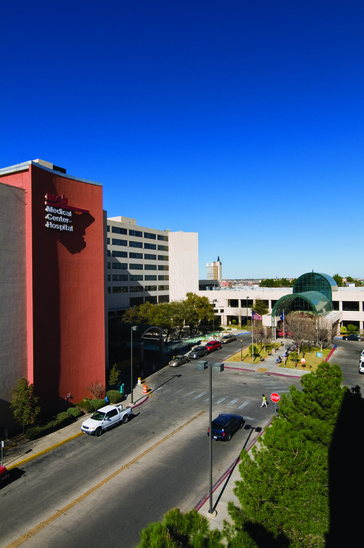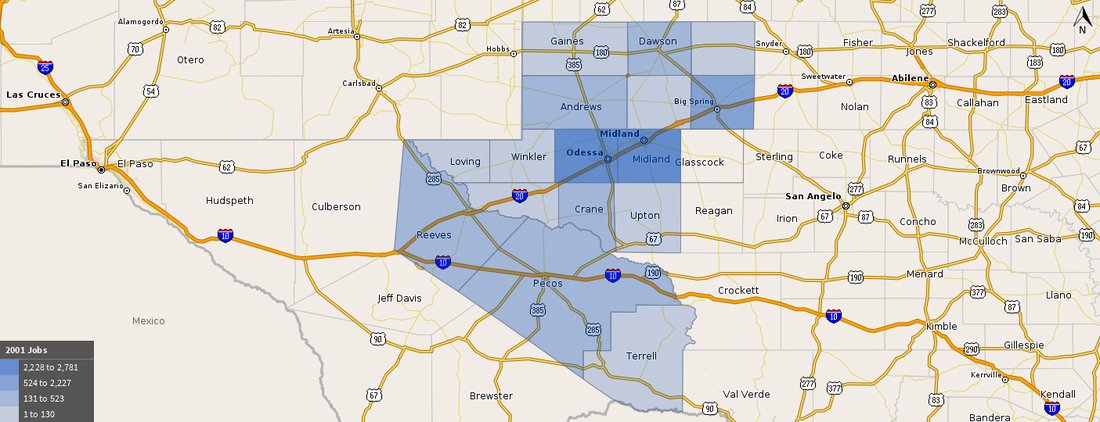The region's Biomedical and Life Sciences Cluster is projected to grow 18.4% (employment) over the next five years, providing residents with quality skilled employment opportunities and diversifying the regional economy. The Cluster includes a diversity of industries from traditional health care service delivery in hospitals and clinics to biomedical research and development. Continued growth of the cluster will be driven and characterized by Permian Basin's unique regional assets and motivators.
- The network of regional hospitals and clinics have received significant investments to improve capacity and enhance technology in recent years. These local serving operations will continue to grow with the Permian Basin population. This traditional healthcare network, however, is uniquely suited to triage trauma cases as a result of concentration of oil and gas production employees.
- Assisted living and nursing home facilities are prevalent throughout the region to accommodate the region's aging population. Several communities, including Big Spring and McCamey, have targeted development to create attractive retirement communities.
- The Texas Tech Health Science Center is a strong research and development asset for the region. Health Science Centers are sources of innovation, patenting, and commercialization when leveraged with effective venture capital, angel investment, and business incubators.
The Biomedical and Life Sciences Cluster can be a source of gross regional product and employment opportunities for years to come with continued sustained investment by communities and economic developers in growing traditional health care and innovation, research and development assets.
The industry group that comprises the cluster, includes.
- The network of regional hospitals and clinics have received significant investments to improve capacity and enhance technology in recent years. These local serving operations will continue to grow with the Permian Basin population. This traditional healthcare network, however, is uniquely suited to triage trauma cases as a result of concentration of oil and gas production employees.
- Assisted living and nursing home facilities are prevalent throughout the region to accommodate the region's aging population. Several communities, including Big Spring and McCamey, have targeted development to create attractive retirement communities.
- The Texas Tech Health Science Center is a strong research and development asset for the region. Health Science Centers are sources of innovation, patenting, and commercialization when leveraged with effective venture capital, angel investment, and business incubators.
The Biomedical and Life Sciences Cluster can be a source of gross regional product and employment opportunities for years to come with continued sustained investment by communities and economic developers in growing traditional health care and innovation, research and development assets.
The industry group that comprises the cluster, includes.
Economic Impact

- 313 Establishments in the region
- 1.78 Jobs Multiplier
- 79.0% of Jobs are held by females
Industry Requirements: Industry / Amount / In-Region / Out of Region
Offices of Real Estate Agents and Brokers / $12,002,208 / 45.7% / 54.3%
Other Activities Related to Real Estate / $8,321,361 / 47.8% / 52.2%
Lessors of Residential Buildings and Dwellings / $17,064,444 / 51.7% / 48.3%
Corporate, Subsidiary, and Regional Managing Offices / $15,336,071 / 9.8% / 90.2%
Lessors of Nonresidential Buildings (except Miniwarehouses) / $15,670,141 / 47.1% / 52.9%
Employment Outlook
In 2014, the region maintained an estimated 9,932 jobs in the Biomedical and Life Sciences Cluster, 52% below national average for a typical region the size of Permian Basin. Employment is projected to grow 18.4% from 2014 to 2019 versus a projected 25.5% growth rate nationwide during the same timeframe. Average earnings for jobs in the cluster are approximately $39,132, 35.4% lower than the national average.
Within the cluster, the occupations with the highest concentration of jobs include:
- 1,635 Personal Care Aides
- 1,097 Home Health Aides
- 952 Registered Nurses
- 951 Nursing Assistants
- 647 Licensed Practical and Vocational Nurses
Within the cluster, the occupations with the highest concentration of jobs include:
- 1,635 Personal Care Aides
- 1,097 Home Health Aides
- 952 Registered Nurses
- 951 Nursing Assistants
- 647 Licensed Practical and Vocational Nurses
Economic Development Catalysts

Midland Memorial Hospital opened a new seven-story patient tower in December 2012, enhancing the medical technology available to the community and improving the health care capacity of the region. The budget for the project was $177.6 million.
The Midland Development Corporation has committed several million dollars in funding to recruit physicians that grew up in the region, back to the region to practice in local health care facilities.
The City of McCamey in March of 2014 broke ground on a new hospital, a 32 bed nursing home and rural health clinic in the McCamey County Hospital District, a $25 million project to expand the community's health care capacity.
The City of Big Spring is home to a unique cluster of health care facilities that are critical resource for Big Spring and surrounding rural west Texas communities. The community boasts a 150 bed private hospital serving the general public, a Department of Veteran Affairs Medical Center, a State mental health facility and a Texas State Veterans Home. There is also premier rehabilitation facilities providing physical therapy, occupational therapy, cardiac rehabilitation, audiolgy, and wellness programs, as well as several facilities that provide housing for the elderly, assisted living facilities, nursing homes, and in home health care.
Odessa's Medical Center Hospital (MCH) achieved level-two status in 2013, after nearly three years of preparation, including the addition of cutting edge medical technology. MCH is the only level two facility in the Permian Basin. The designation will help decrease in the need to transfer patients to other facilities and will allow the facility to treat most people.
Odessa Regional Medical Center (ORMC) continues to make investments to improve access and reach vulnerable communities. In 2014, ORMC launched a Health Screening Van service, providing angio-screening services for a small fee to communities throughout the area. ORMC offers comprehensive services including neonatal intensive care (NICU), high-risk obstetrics, maternal/child, cardiac, orthopedics, critical-care, and medical-surgical care. To insure faster access of these services, ORMC features a state-of-the-art, 10,000 square foot helipad for accepting air-ambulance helicopter transports throughout the region.
MORE COMING SOON...
The Midland Development Corporation has committed several million dollars in funding to recruit physicians that grew up in the region, back to the region to practice in local health care facilities.
The City of McCamey in March of 2014 broke ground on a new hospital, a 32 bed nursing home and rural health clinic in the McCamey County Hospital District, a $25 million project to expand the community's health care capacity.
The City of Big Spring is home to a unique cluster of health care facilities that are critical resource for Big Spring and surrounding rural west Texas communities. The community boasts a 150 bed private hospital serving the general public, a Department of Veteran Affairs Medical Center, a State mental health facility and a Texas State Veterans Home. There is also premier rehabilitation facilities providing physical therapy, occupational therapy, cardiac rehabilitation, audiolgy, and wellness programs, as well as several facilities that provide housing for the elderly, assisted living facilities, nursing homes, and in home health care.
Odessa's Medical Center Hospital (MCH) achieved level-two status in 2013, after nearly three years of preparation, including the addition of cutting edge medical technology. MCH is the only level two facility in the Permian Basin. The designation will help decrease in the need to transfer patients to other facilities and will allow the facility to treat most people.
Odessa Regional Medical Center (ORMC) continues to make investments to improve access and reach vulnerable communities. In 2014, ORMC launched a Health Screening Van service, providing angio-screening services for a small fee to communities throughout the area. ORMC offers comprehensive services including neonatal intensive care (NICU), high-risk obstetrics, maternal/child, cardiac, orthopedics, critical-care, and medical-surgical care. To insure faster access of these services, ORMC features a state-of-the-art, 10,000 square foot helipad for accepting air-ambulance helicopter transports throughout the region.
MORE COMING SOON...

